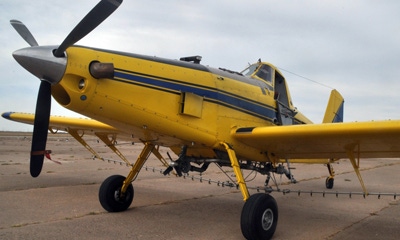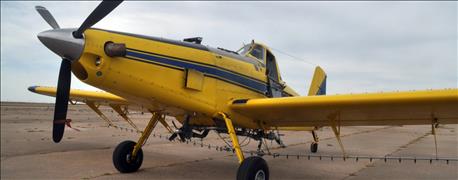
It's not common for Kansas farmers to plant seed from the air. But it can be done, and sometimes it is the best option.
When Barber County farmer Chris Boyd wanted to get forage cover crops planted earlier so his cornstalks would be ready for grazing sooner, he turned to Warren Sturgeon at Farmers Spraying Service Inc. in Pratt to plant his cover crop of winter wheat and tillage radishes into his ripening corn.
Farmers Spraying pilot Josh Heagle flew the seed on the first week of September. By the time Boyd harvested his corn a month later, the field was already green.

AERIAL SEEDING: Sowing seed from the air allows getting a cover crop up and growing even before fall crops are harvested.
He plans to have cattle on the field by early November, a significant head start on what grazing would have been possible had he waited to conventionally plant after corn harvest.
Sturgeon says the base of his business remains spraying chemicals — herbicide, fungicide and insecticide — but he has planted soybeans from the air in wet years and has done a lot of alfalfa seeding.
"Planting from the air is big in rice country. They do it all the time, so the technology has been around a long time," he says.
He says converting his 502 Air Tractor or 402 Air Tractor from a spray plane to a seed plane is relatively simple and takes about a half-day of work.
"The bottom of the hopper opens up and the seeder mounts underneath," he says. "It puts out about an 80-foot strip of seed and drops it pretty evenly."
He says air seeding works best on irrigated land, where the producer can run the pivot for two or three passes to keep the ground wet enough for the seed to germinate.
"We flew seed onto corn and soybean fields for Chris and onto cotton for Craig Mease this year," Sturgeon says.
Farmers Spraying is a veteran crop dusting company, started by Sturgeon in 1976. Today, his youngest son, Tony, is one of two pilots flying for Farmers Spraying. Heagle is the other.
"I haven't flown for two years. I am 76 years old, and I couldn't pass the physical to keep my license," he says. He remains active in the business, however, and says 2016 was a busy year, with heavy weed and fungal disease pressure and wet fields.
"I think if prices had been better, we would have been even busier," he says.
He also sees growth potential in early cover crop seeding.
"A lot more farmers are seeing the value in cover crops," he says. "Those radishes are really popular."
For cattlemen who want to graze winter wheat pasture or a forage cover crop, getting it up and growing sooner can be important to the bottom line.
Boyd says that was important to him. The green forage improves the nutritional value of cornstalk pasture and reduces the need for supplemental feeding, he says.
Sturgeon says seeding by air costs about 50% more than conventional planting but has an advantage in that it can be planted into a standing crop.
He says he does not fly cover crop mixes that contain rye because of the risk of accidentally planting it where it isn't wanted.
"We fly wheat country, and those farmers really, really don't want rye," he says. "So I just don't seed rye."
About the Author(s)
You May Also Like






